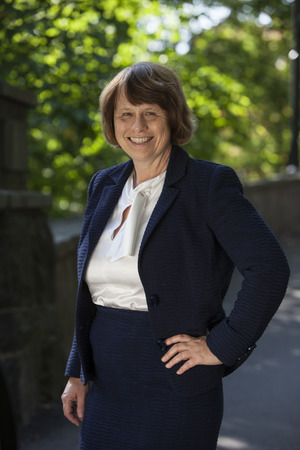Ewine van Dishoeck facts for kids
Quick facts for kids
Ewine van Dishoeck
|
|
|---|---|

Ewine van Dishoeck (2014)
|
|
| Born | 13 June 1955 |
| Spouse(s) | Tim de Zeeuw |
| Awards |
|
| Scientific career | |
| Fields | Astrochemistry, Astronomy, Chemistry |
| Doctoral advisors |
|
Ewine Fleur van Dishoeck, born on June 13, 1955, in Leiden, Netherlands, is a famous Dutch astronomer and chemist. She is a professor at Leiden Observatory, where she studies how molecules behave in space. From 2018 to 2021, she was the President of the International Astronomical Union, a big group of astronomers worldwide. She also helps edit a major astronomy journal. Ewine van Dishoeck is a leader in a field called astrochemistry. Her research helps us understand what cosmic objects are made of by looking at their molecular light.
Contents
Early Life and Inspiration
Ewine Fleur van Dishoeck was born in Leiden, Netherlands. Her father was a professor who studied ear, nose, and throat medicine. When Ewine was 12, her father's work inspired her love for science.
At that time, her father was invited to work in San Diego, California, for six months. Ewine took her first science class there. She remembers her science teacher, a woman who had overcome many challenges to become a teacher in the 1960s. This experience motivated Ewine to pursue a career in science, especially chemistry.
Education and Career Path
Ewine van Dishoeck started studying chemistry at the University of Leiden in the Netherlands. She soon found that physics also interested her. Her focus shifted towards chemical physics, especially quantum chemistry, for her senior research project.
A challenge arose when the only professor specializing in quantum chemistry at Leiden passed away. For a PhD in Holland, a full professor must supervise your thesis. Ewine needed to find a new field of study if she wanted to stay at Leiden.
Her boyfriend, and future husband, Tim de Zeeuw, was studying astronomy. He told her about interstellar molecules and a leading expert, Alex Dalgarno, at Harvard University. In 1980, Ewine went to study with Dalgarno. She changed her main field to astrochemistry. She earned her PhD by studying how molecules in space clouds get excited and break apart.
After her PhD, she returned to Cambridge, Massachusetts. She joined Harvard's Society of Fellows to continue her important research on the interstellar medium. Since 2007, she has been the scientific director of the Netherlands Research School for Astronomy (NOVA).
What Ewine van Dishoeck Studies
Ewine van Dishoeck studies molecules found in the space between stars, called the interstellar medium. She looks at how these molecules change as stars and planets form. Her work involves using special telescopes that can see submillimeter and mid-infrared light. This helps her understand basic molecular processes and how light travels through space.
In 2021, she received a special grant to study the chemistry and physics in disks of gas and dust around other stars. These disks are where new planets are forming. She is known as the most cited molecular astrophysicist in the world. This means her work is very important and often referred to by other scientists.
Her Impact on Science
Ewine van Dishoeck's work in astrochemistry has been key to understanding how gas and dust in space can eventually lead to living things. Life needs carbon, and space has a lot of carbon in the form of carbon monoxide. However, ultraviolet light (UV) from stars can break up carbon monoxide.
During her PhD studies, scientists wondered how some carbon monoxide molecules could survive in space. Ewine set up models of interstellar clouds in her lab. She compared her tests with actual observations from space. She found that carbon monoxide is not affected by all UV light. It is only sensitive to specific wavelengths it can absorb.
She and John Black discovered that dust and other molecules in space can block UV light. This protection allows carbon monoxide to survive. Her findings explained why these molecules could last long enough to help form living organisms.
Awards and Recognition
Ewine van Dishoeck has received many awards for her amazing work.
- In 1984, she was a Junior Fellow at the Harvard Society of Fellows.
- She received the Gold Medal of the Royal Netherlands Chemical Society in 1994.
- She won the Spinoza Prize in the Netherlands in 2000.
- The Royal Society of Chemistry in the UK gave her the Bourke Award in 2001.
- Since 2001, she has been a member of the Royal Netherlands Academy of Arts and Sciences and the United States National Academy of Sciences.
- In 2013, she joined the Academy of Sciences Leopoldina.
- She received the Gothenburg Lise Meitner Award in Sweden in 2014.
- In 2015, she won the Albert Einstein World Award of Science in Mexico.
- In 2018, she was awarded the James Craig Watson Medal in the US and the Kavli Prize for astrophysics in Norway.
- That same year, she became an Honorary Member of the Royal Netherlands Chemical Society.
- In 2020, she was elected to the American Philosophical Society and received the Prix Jules Janssen.
- In 2021, Pope Francis appointed her to the Pontifical Academy of Sciences. She also received the Nick Kylafis Lectureship.
- In 2022, Ewine van Dishoeck was awarded the Fritz Zwicky Prize for Astrophysics and Cosmology and the Niels Bohr International Gold Medal.
Personal Life
Ewine van Dishoeck is married to Tim de Zeeuw. He is also a professor of astronomy at Leiden University. He was the Director General of the European Southern Observatory from September 2007 to 2017.
See also
 In Spanish: Ewine van Dishoeck para niños
In Spanish: Ewine van Dishoeck para niños

